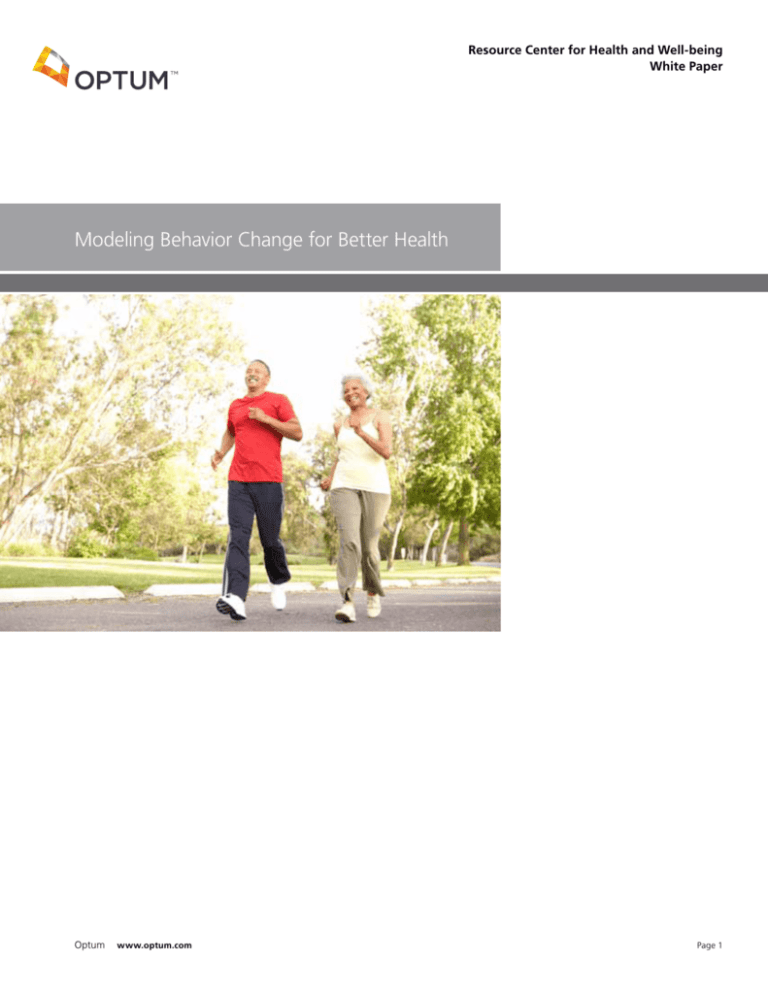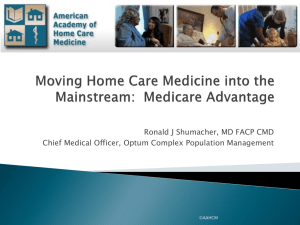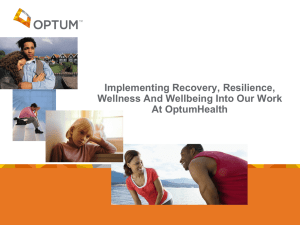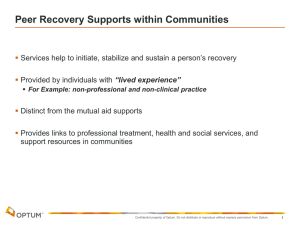
Resource Center for Health and Well-being
White Paper
Modeling Behavior Change for Better Health
Optum
www.optum.com
Page 1
Optum Modeling Behavior Change for Better Health White Paper
White Paper
Changing Behaviors: The Highest Health Hurdle
There is one fact about our current health crises with which all investigators agree: the
state of our health and the rate of our health care spending are both directly related —
for better or worse — to our behavior. Any effort to increase wellness, manage risks,
reduce costs or improve condition management inevitably turns to a change in some
aspect of lifestyle or behavior, and the need for population-scale change is inarguably
urgent. Consider just a few data points:
• According
to the Centers for Disease Control and Prevention, more than one-third of
U.S. adults (35.7 percent) are obese.1
• Between
1999–2000 and 2009–2010, the percentage of adults aged 45–64 and 65
and over with two or more chronic conditions (hypertension, heart disease, diabetes,
cancer, stroke, chronic bronchitis, emphysema, current asthma and kidney disease)
increased for both men and women, all racial and ethnic groups examined, and most
income groups.2
CMS economists predict that
average annual spending on
health care in the United States
will outpace the growth of the
GDP by 1.1 percent and reach
$4.6 trillion by 2020, nearly 20
percent of the nation’s expected
economic output.
Source: http://content.healthaffairs.org/
content/early/2011/07/27/hlthaff.2011.0662.full
Yet all of us know, often to our chagrin, that an entrenched behavior can be remarkably
resistant to change. In some sense, each is a successful adaptation that delivers
something of value within the uniquely personal context of an individual’s knowledge,
beliefs, attitudes, values, cultural norms and social environment. Because motivation
arises within these very specific conditions, lasting change can only be achieved through
informed interventions that modify the behavioral context to elicit different motivations
and reward different decisions. This, in turn, requires a subtle understanding of how
behavior develops and why it occasionally changes.
The Science of Behavior and Change
Fortunately, the study of behavior is common to modern psychology, social science,
economics and education. There is a great deal of settled knowledge about how
behaviors arise and under what circumstances they change. The modern world
looks and works as it does in large part because marketers have learned to use this
knowledge so profitably, and there is no reason why health and wellness practitioners
shouldn’t be equally proficient.
The modern study of behavior took flight with (and then, in many cases, from)
Freud’s work on the psychopathology of neuroses and hysterical disorders. The first
empirical investigation to yield a useful change methodology was Pavlov’s work on the
conditioning of reflexive behaviors (classical conditioning) at the turn of the twentieth
century. This was followed in mid-century by the development of operant conditioning,
which emerged from the work of B.F. Skinner and dealt with the modification of
voluntary behaviors through their environmental consequences.
One of the most influential applications of behavioral science to health-related
behaviors occurred in the 1970s with the development of the stages of change model,
also known as the transtheoretical model. The originators, Prochaska and DiClemente,
were searching for a more effective smoking cessation methodology. Several ideas from
the stages model — that change is a sequential and often iterative process that unfolds
over time, in which barriers must be identified and overcome, and in which no stage
can be successfully negotiated until the individual is fully prepared — have become
embedded in many subsequent efforts to systematize our understanding of behavior
and health.
Optum
www.optum.com
2
Optum Modeling Behavior Change for Better Health White Paper
White Paper
The ASM Model
At Optum™, our approach to shaping health behavior to drive engagement in health
improvement programs is structured around a three-stage model that draws on the
leading theories of behavior change and applies their insights to operational practice.
Like the transtheoretical model, our approach views behavior change as a process
continuum and accepts the idea that to be successful, programmatic interventions
must address the specific needs and opportunities of an individual subject at his or her
current state of progress. It also acknowledges the broader context — social, cultural
and environmental — within which behaviors arise and change. Our model takes its
name — ASM — from the three stages it describes: awareness, skill building, and
maintenance.
Figure 1. The ASM behavior change model
Awarenes
Sustained behavior
• Practice and
internalization
• Repetition; habit
formation
s
M a i nt
Behavior
change
ui
ce
ld
an
in g
en
Call to action
• Perceived benefits/barriers
• Health perceptions
• Value-based motivation
Sk
ill
b
Practice and mastery
• Chunking tasks; building successes
• Building self-confidence
• Generating a sense of accomplishment
Stage One: Awareness and Motivation
No one undertakes the discomfort and sustained effort that are necessary to change
an established behavior without powerful motivation, and an essential precursor to
motivation is the awareness of a serious health risk. The first phase of the ASM model
describes the specific characteristics of risk awareness that must be achieved, and
the role of program communications in creating awareness and driving the transition
to motivation. The model posits three aspects of awareness that must be satisfied in
order to create a strong and persistent determination:
• The
individual must be made aware that an existing behavior is directly responsible
for a significant health risk.
• The
present risk must be perceived as sufficiently immediate and severe that the
benefits of immediate action outweigh whatever value is associated with the
existing behaviors and justify the investment of energy required to surmount the
inevitable barriers.
• Our
communications must specifically address any individual attitudes or cultural
beliefs that support existing behaviors and mediate against change. They must
include specific cues to take action, and must be regularly repeated.
Optum
www.optum.com
3
Optum Modeling Behavior Change for Better Health White Paper
White Paper
In its description of the awareness stage of behavior change and the specific
requirements of program communications intended to create and build motivation, the
ASM model incorporates essential insights from several established behavioral theories.
In particular, we draw on:
• Health
belief theory, a model of health service utilization developed by Irwin
Rosenstock and colleagues beginning with research they conducted for the U.S.
Public Health Service on why some people — and not others — sought out clinical
assessment for tuberculosis. This model holds that the likelihood of an individual
taking action to change a health behavior is a function of his or her perceived
susceptibility to a specific health risk, the perceived severity of that risk, and the
perceived benefit of change relative to the barriers and costs. It notes the subjective
nature of perception and the impact of various mediating factors (personal attitudes,
cultural values).3
• Balance Theory is a model developed by Fritz Heider in the 1940s that describes
the role of social influences in an individual’s adoption and modification of personal
attitudes and motives. It proposes an interplay between two psychological needs:
(1) to maintain cognitive consistency over time, and (2) to balance personal attitudes
with those held by important social contacts. It even offers a notational system for
determining the least costly — and most likely — adaptation.4
• Reasoned Action Theory, developed by Martin Fishbein and Isek Ajzen in the
1970s and ‘80s, describes behavior as the outcome of an interaction between
personal attitudes and the attitudes of an individual’s social network, called
subjective norms by the authors. The model allows for individual weighting of
attitude and social norms in every instance, and predicts the importance of directly
addressing social context to achieve a desired behavioral outcome.5
• Goal
Setting Theory as developed by Edwin Locke and Gary Latham, who made
separate studies of the relationship between goal formation, motivation and
workplace performance before joining forces to publish “A Theory of Goal Setting
& Task Performance.” They describe five attributes of well-set goals that correlate
with high levels of motivation and achievement: clarity, challenge, commitment,
feedback and task complexity. In addition, they note the importance of avoiding
conflict between individual goals, and of setting attainable short-term goals to
enhance motivation.6
Stage Two: Skill Building
With the necessary risk awareness and motivation in place to initiate and sustain action,
the second stage of the ASM model focuses on the necessary skills to achieve success,
and on the unique process by which each individual develops those skills. Replacing an
ingrained behavior is a learning process that requires the development of new critical
disciplines, and of a personal methodology for incrementally exchanging high-risk
behaviors for healthy ones. Any educational intervention to support this learning must
reflect an accurate understanding of the skills that enable behavior change, the process
through which these skills are acquired, and the wide range of personal and social
factors that can facilitate or inhibit learning. Critical factors for successfully supporting
skill development include:
• An understanding that self-confidence is essential, and that both confidence and
motivation are acquired through incremental successes and eroded by failure
• A program design tailored to the problem-focused learning style that is typical of adults
• Communication messaging that is carefully designed to elicit the most efficient responses
Optum
www.optum.com
4
Optum Modeling Behavior Change for Better Health White Paper
• A goal-setting strategy that divides large tasks into smaller, more easily
accomplished components
• Specific goals that are clear, measurable and consistent
In its description of the skill-building stage of behavior change and the specific
requirements of program communications intended to support and expedite the
learning process, the ASM model incorporates essential insights from several established
behavioral theories, including:
• Self-efficacy theory is a core component of the larger social cognitive theory
developed by psychologist Albert Bandura. Its central concept is the idea that an
individual’s belief in his or her ability to succeed in an undertaking determines
behavior and outcomes. Thus the use of fear arousal messages in program
communications must be carefully calibrated.
White Paper
A message that stimulates and
motivates one individual with a
high level of self-efficacy could
easily inhibit another with less
self-confidence.
Source: Albert Bandura, Self-efficacy:
Toward a Unifying Theory of Behavioral
Change, Psychological Review, Vol. 84,
No. 2, 191-215, 1977
• Adult learning theory originates in the work of Malcolm Knowles, who introduced
the term andragogy to distinguish the practice of instructional design for adults from
pedagogy, the practice of instructing children. According to Knowles, there are several
characteristics that typify and distinguish adult learning. Adults are most interested in
learning things that will be of immediate value in their professional roles or personal
pursuits. They assess new information in the context of their own personal life
experiences, and their learning style is problem-centered, not subject-oriented.7
• Goal-setting theory, particularly the ideas that goals with measurable achievement
metrics promote the development of self-efficacy, and that there should be a
transition from shorter-term to longer-term goals as an individual progresses through
the skill-building process.
Stage Three: Long-term Maintenance
If initiating a positive change in health behavior is hard — and it is — then preserving
that change until it becomes ingrained is harder by far. But if beneficial changes don’t
persist, then the organization’s investment in initiating those changes and its longterm goals for better health and lower costs are both at risk. Thus the third stage of
the ASM model describes the mechanisms by which new behaviors become fixed, and
the requirements of program interventions that seek to reinforce healthy change and
preventing relapse. Several factors are critical, including:
• Regular program communications that continuously reinforce an individual’s
awareness of the health benefits of his or her new behaviors, and the risks of
returning to old habits
• Regular reinforcement from the individual’s social network, including testimonials and
personal examples by peers and leadership figures
• A transition in program reinforcements from extrinsic incentives to internal rewards,
supported by program messaging that links healthy change to self-identity
• Consistent support in the workplace culture and physical environment
Optum
www.optum.com
5
Optum Modeling Behavior Change for Better Health White Paper
In describing the maintenance stage of behavior change and the specific
requirements of program communications intended to sustain healthy change over
the long term, the ASM model incorporates key insights from several established
behavioral theories, including:
• Reinforcement theory is a component of behavior modification theory with roots
in Skinner’s operant conditioning. It describes the function of external reinforcements
in increasing the frequency of desired behaviors, the effects of positive and
negative reinforcement, and the differing impacts of various delivery schedules.
Reinforcement theory provides a foundation for developing incentive strategies that
effectively combine specific incentive types, values and behavioral targets. It also
affirms the importance of other factors in supporting engagement and motivation,
including social and cultural support, consistent communication, and a relevant mix
of programs. And finally, reinforcement theory tells us that for behavior change to
become permanent there must be a transition from external incentives to internal
motivation based on an experiential appreciation of the new behavior’s intrinsic value.8
White Paper
Studies by Victor Strecher and
others confirm that longitudinal
engagement and behavioral
outcomes are significantly
enhanced when communications
are personalized to directly
address a user’s age, gender,
ethnicity, attitudes and other
personal attributes.
Source: http://www.jmir.org/2008/5/e36/
• Relevance is a conceptual component of human information processing theory which
holds that individuals are more likely to remain engaged with a behavior change
program over time, and to succeed in maintaining a health-related behavior change,
when program communications are regularly repeated and personally relevant.
• Social learning theory, which tells us that confirmation and encouragement from
an individual’s social network can be as important as external incentives in reinforcing
and preserving beneficial behavior change.9
Turning Behavioral Science into Best Practice Programs
The ASM model provides the structural framework for Optum health improvement
programs that seek to improve a population’s health by changing its members’
high-risk behaviors and supporting existing healthy lifestyles. Whatever the
health issue or behavioral target, our goal is that all interventions follow the same
conceptual sequence.
First, build awareness of a specific health issue. Clearly establish its severity, its roots in
existing behaviors, and the benefits of a specific change. Second, focus the resulting
motivation on building self-efficacy through incremental mastery of specific skills and
successful replacement of poor habits with healthier behaviors. Finally, strengthen
and sustain the new norms through ongoing communication, consistent social and
environmental support, and a phased transition from external to intrinsic reinforcement.
Consider these three examples.
ASM in Action: Making Physical Exercise a Daily Habit
In applying the ASM model to any behavior change exercise, we begin with the insight
that every individual behavior is shaped and sustained by a combination of personal,
social and environmental influences. To create lasting change at the personal level,
we must also change the external influences by creating both a culture of health in
the organization and a physical environment that accommodates and encourages the
changes we seek.
Optum
www.optum.com
6
White Paper
Optum Modeling Behavior Change for Better Health White Paper
Figure 2: A comprehensive framework for behavior change programming
Individual
Motivation
and Awareness
Skill Building
Maintenance/
Reinforcement
Organizational
Environmental
Assessments
Tailored messaging
Policies
Leadership visibility
Posters
Floor stickers
Coaching classes
Flexible work time
Onsite fitness equipment
Walking paths
Conducive stairs
Support groups
Reminder messages
Rewards
Incentives
Organizational
recognition/rewards
Access to equipment
Structural design facilitates
activity
In the physical exercise example shown in figure 2, the individual activities planned for each
stage in the ASM change process are supported by developments in the organizational
culture and physical environment that are designed to encourage and sustain the target
behaviors. The model provides a comprehensive framework for identifying and accomplishing
all changes in the social context and physical environment that are necessary to initiate,
inform and maintain individual behavior change at population scale.
ASM in Action: Synchronizing Educational Content Delivery
The Optum health and wellness website team curates educational content on a wide
range of health topics and online programs for delivery through the LEARN section of our
employer portal. The team maps all of its selected content to the ASM model’s behavior
change phases so that every user can find relevant and engaging information for their own
stage of their own health journey. Figure 3 shows an example of diabetes management
information mapped to the sequential phases of awareness, skill building and maintenance.
The team also uses the ASM model in gap analyses to ensure that appropriate content is
available to support the entire behavior change process, and is working to apply the model
to content evaluation for its online program learning modules.
Figure 3: ASM stage sequencing for online diabetes educational content
Awareness
Overview +
Prediabetes
Diabetes
Type 1
Diabetes
Type 2
Gestational
Diabetes
Living with
Diabetes
Optum
Skill Building
Maintenance
Should you be tested
for diabetes?
30 ways to trim 100
calories
Mediterranean Diet may
help prevent diabetes
Just diagnosed?
Manage Type 1
diabetes
Your teen and Type 1
diabetes
Preventing
complications from
Type 1 diabetes
Questions to ask your
doctor about Type 2
diabetes
The best exercise
plan for Type 2
diabetes
The link between sleep
and Type 2 diabetes
What is gestational
diabetes?
Oral glucose
tolerance test
Gestational diabetes:
What happens after my
baby is born?
“You can’t eat sugar”
and other diabetes
myths
Recipe substitutions
for healthier meals
Diabetes and foot care
www.optum.com
7
Optum Modeling Behavior Change for Better Health White Paper
White Paper
ASM in Action: Wellness Consulting and Strategic Planning
The Optum wellness consulting team has embedded the ASM model in its assessment
processes and the strategic plans it develops for its customers. The team has created
a standard set of behavior change solutions for each of the most common population
health risks it encounters in its employer consulting engagements. The deliverables for
each risk solution include a multi-year package of recommended programs, services,
resources, incentives and environmental adaptations that are based on an ASM
approach to the required behavior change. Each solution is modified to reflect the
specific population characteristics, and becomes part of a 3–5 year strategic plan to
reduce health risks and costs for that customer.
Changing Behaviors, Saving Lives
Changing health-related behaviors is unquestionably hard, but it can be done
successfully, consistently, cost-effectively and at population scale. The key to success
is an actionable model of behavior change that fully reflects the complex relationships
between individual, attitude, culture, society and the physical world. Only when an
intervention program targets the critical individual, organizational and environmental
factors that reward and sustain high-risk behaviors can an effort to replace it succeed
and more desirable behaviors take permanent root. The ASM model provides Optum
wellness programs with exactly this type of insight, and gives them an unprecedented
capacity to empower individuals and improve lives.
Sources:
1
http://www.cdc.gov/nchs/data/databriefs/db82.pdf
2
http://www.cdc.gov/nchs/data/databriefs/db100.htm
3
http://deepblue.lib.umich.edu/bitstream/2027.42/67783/2/10.1177_109019
818801500203.pdf
4
Heider F (1958) The psychology of interpersonal relations, New York: Wiley
5
Ajzen I and Fishbein, M. Understanding attitudes and predicting social behavior.
Englewood Cliffs, NJ: Prentice-Hall, 1990
6
Locke E, Latham G, Smith K, Wood R and Bandura A. A Theory of Goal Setting &
Task Performance; Prentice Hall College Division, January 1990
7
Knowles M. The Modern Practice of Adult Education: From Pedagogy to
Andragogy, Cambridge Book Co, 1988
8
Serxner S. (2013). A different approach to population health and behavior change:
Moving from incentives to a motivation-based approach. American Journal of
Health Promotion/The Art of Health Promotion March/April: 4-7
9
Bandura A. Self-efficacy: Toward a Unifying Theory of Behavioral Change,
Psychological Review, Vol. 84, No. 2, 191-215, 1977
Optum
www.optum.com
8
Optum Modeling Behavior Change for Better Health White Paper
White Paper
About the Author
Seth Serxner, Senior Vice President of Population Health, Optum
Seth Serxner brings the breadth of his experience in academia, industry and consulting
to his role as senior vice president of population health for Optum. His versatile skill set
ensures processes and outcomes that improve health for clients in all markets. Seth’s
deep knowledge of behavior change, population health and measurement allow him to
visualize and deliver on program innovation. He has more than 25 years of experience in
health and productivity management and has published more than 30 articles.
Seth came to Optum from Mercer’s Total Health Management specialty, where he
served as partner and senior consultant for nine years. During his tenure there he
established himself as a national expert on behavior change, program design and
measurement. He spent a decade each in academia and private industry before
becoming a consultant. He is a board member, executive committee member and vice
president of the C. Everett Koop Health Project. He also sits on the editorial review
board of the American Journal of Health Promotion and edits and is a reviewer for peer
review journals such as the Journal of Occupational and Environmental Medicine and
Health Affairs.
Contact Us:
T 866-386-3408
resourcecenter@optum.com
www.optum.com/resourcecenter
www.optum.com
13625 Technology Drive, Eden Prairie, MN 55344
All Optum trademarks and logos are owned by Optum, Inc. All other brand or product names are
trademarks or registered marks of their respective owners. Because we are continuously improving our
products and services, Optum reserves the right to change specifications without prior notice. Optum is an
equal opportunity employer.
© 2013 Optum, Inc. All rights reserved. OPTPRJ2241
9









